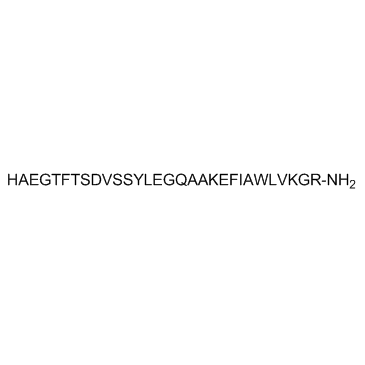Glucagon-Like Peptide (GLP) I (7-36), amide, human |
| カタログ番号GC36150 |
グルカゴン様ペプチド (GLP) I (7-36)、アミド、ヒトは、インスリン分泌を刺激する生理的インクレチン ホルモンです。
Products are for research use only. Not for human use. We do not sell to patients.

Cas No.: 107444-51-9
Sample solution is provided at 25 µL, 10mM.
Glucagon-Like Peptide (GLP) I (7-36), amide, human is a physiological incretin hormone that stimulates insulin secretion.
The sequence of Glucagon-Like Peptide after residue 7 shows similarities to glucagon and to other biologically active members of the secretin peptide family, particularly glucose-dependent insulinotropic peptide (GIP). This sequence has been especially well preserved, showing 66% nucleotide homology with GLP-1 in the proglucagon of the very primitive anglerfish. This 7-36 sequence of GLP-1 is a potent insulin-releasing peptide in vitro[1]. Glucagon-Like Peptide (GLP) I (7-36), amide is a product of the tissue-specific post-translational processing of the glucagon precursor. It is released postprandially from intestinal endocrine L cells and stimulates insulin secretion. DPP IV is the main degradation enzyme for GLP-l(7 - 36)amide in human serum. Dipeptidyl-peptidase IV can initiate the metabolism of GIP and GLP-1(7-36)amide in human serum[2].
Glucagon-Like Peptide (GLP) I (7-36), amide is a physiological incretin hormone that is released after nutrient intake from the lower gut and stimulates insulin secretion at elevated plasma glucose concentrations. Exogenous GLP-1 (7-36 amide) is an effective means of normalizing fasting plasma glucose concentrations in poorly-controlled Type 2 diabetic subjects[3]. Exogenously administered GLP-1-(7-36)amide is extremely labile in vivo, with more than 80% being cleaved into GLP-1-(9-36)amide after sc or iv administration[4].
[1]. Kreymann B, et al. Glucagon-like peptide-1 7-36: a physiological incretin in man. Lancet. 1987 Dec 5;2(8571):1300-4. [2]. Mentlein R, et al. Dipeptidyl-peptidase IV hydrolyses gastric inhibitory polypeptide, glucagon-like peptide-1(7-36)amide, peptide histidine methionine and is responsible for their degradation in human serum. Eur J Biochem. 1993 Jun 15;214(3):829-35. [3]. Nauck MA, et al. Normalization of fasting hyperglycaemia by exogenous glucagon-like peptide 1 (7-36 amide) in type 2 (non-insulin-dependent) diabetic patients. Diabetologia. 1993 Aug;36(8):741-4. [4]. Hansen L, et al. Glucagon-like peptide-1-(7-36)amide is transformed to glucagon-like peptide-1-(9-36)amide by dipeptidyl peptidase IV in the capillaries supplying the L cells of the porcine intestine. Endocrinology. 1999 Nov;140(11):5356-63.
Average Rating: 5 (Based on Reviews and 33 reference(s) in Google Scholar.)
GLPBIO products are for RESEARCH USE ONLY. Please make sure your review or question is research based.
Required fields are marked with *




















